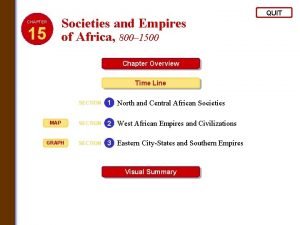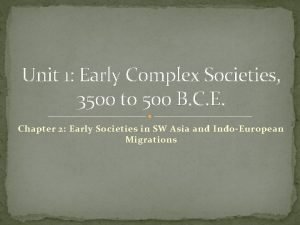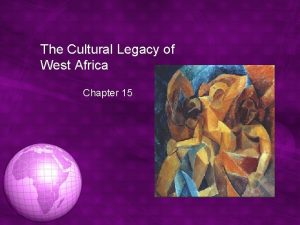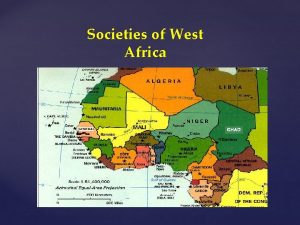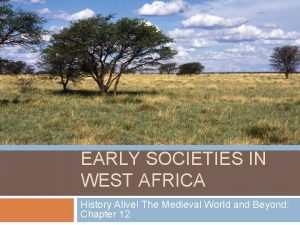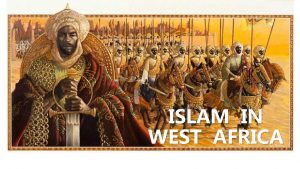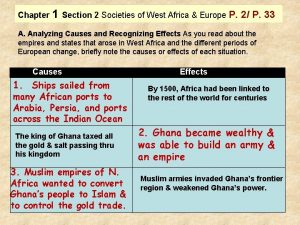Early Societies in West Africa Chapter 12 Words












- Slides: 12

Early Societies in West Africa Chapter 12

Words need to know • Woodland forest – an area of abundant trees and shrubs • Rainforest - an area of lush vegetation and yearround rainfall • Extended family – an immediate family (parents and their children) plus other close relatives, such as grandparents, aunts, uncles, and cousins. • Excavate – in archeology, to carefully dig out an ancient site. • Tribute – a payment made by one ruler or country to another for protection or as a sign of submission

Introduction • 3 kingdoms between 500 - 1600 C. E. – Ghana, Songhai, and Mali • Cities and kingdoms began as family based communities to villages, turned into towns and cities and then became kingdoms • For hundred of thousands of years there were no written records • First started keeping records in 800 s - when Ghana at least 300 years old – By that time they had iron tools for advanced farming methods

• Trade played a major role in the growth of West African societies – Different zones had to trade for things in other zones – Several main rivers served as trade routes traveled by canoe or over the desert • Geography includes – Desert - Sahara approximately 3, 500, 000 square miles in North Africa with scattered oases – Semi desert - Sahel short grasses and small bushes – Savanna - tall grasses and scattered trees long rainy season - millet, sorghum and rice grown - goats, camels, cattle and sheep Niger River keeps nearby land fertile and provides fish for eating – Niger River extends into the forest zone wetter than savanna • Northern part is woodland forest of trees and shrubs - oil palms, yams and kola trees grow here • Southern part is rainforest - rain falls year around - mahogany and teak grow here Geography and trade




Early communities and villages • By 4000 B. C. E. people settled and farmed • First communities – extended families – Aunts, uncles, grandparents, and their children (15 -20 members) – Produced all needed – cleared fields, planted, and harvested crops, traded with other extended families for other needs – Male elder made all decisions for community over time became • Village– contained 100 to 200 people – Leader chosen for his wisdom (banded together extended families) – People work together to control a flood or mine iron or gold – Come together for protection install high walls and gates to protect selves from attacks

Towns and cities • Why did cities develop? • Ironworking and trade – Nok were making iron tools by 500 B. C. E. – Smelting – heating and melting ore to get iron - blacksmiths • Use a lot of charcoal – made axes, hoes and weapons – With iron tools could clear more land grow more crops = more food and freed people to do other trades (weaving, mental work and pottery) – Easy trading for people along the river, they could control trade and charge for trading = grew wealthy • Cities grew along rivers and places with natural resources

Jenne-jeno In West Africa – built in 3 B. C. E. existed for over 1, 600 years Built where Niger River meets Bani River – Good spot for farming, fishing and trade – Traded catfish, fish oil, onions, and rice for salt, iron ore, copper and gold – About 20, 000 people – Surrounded by a 10 foot wide – 13 foot high wall – the wall gave the city status and made it easier to control coming and going traders. • Lived in circular houses – First made of bent poles and woven mats later – mud blocks • Had farmers, potters, metal smiths, weavers, leatherworkers, bead makers, blacksmiths and ivory carvers – Blacksmiths were believed to have supernatural powers, therefore were given many responsibilities – political leaders, judges and doctors – some were charged with predicting the future

• Trade was a major reason for the rise of kingdoms – Ghana, Mali, and Songhai all trading powers ruled over Rise large areas. – – of Kingdoms formed because cities collected taxes from goods kingdoms being sold and bought so they could raise large armies. Then armies could conquer other trading areas nearby, ruler could and takeover and become richer – collected tribute from people they conquered – showed that theyempires accepted king’s authority and to pay for protection – African kings political and religious leaders of kingdoms • Special powers given to them by the gods. – Kingdoms grew into empires • Sent governor to rule or let rule themselves – Disadvantages to becoming an empire • • Obligation to pay tribute Men had to serve in king’s army – Advantages to becoming an empire • • • Protection Trade routes safe No wars between small cities Collected luxury goods and passed out throughout Gave expensive presents to governors kingdom

Chapter Summary • Geography major reason (where located) for development of these societies • Communities grew below Sahara Desert where they could farm • Traded for only what they couldn’t produce • Rivers used as trade routes • Earliest societies were family-based communities • Some joined together to form villages – these allowed people to take advantage of natural resources and protect themselves from attack • Iron making and trade (important trading sites) helped them to grow into towns and cities. • Iron tools allowed farmers to grow food more efficiently – So other people could engage in other crafts • Villages traded surplus food • Trade brought cities great wealth – conquered neighboring areas and became kingdoms and empires
 Chapter 18 states and societies of sub-saharan africa
Chapter 18 states and societies of sub-saharan africa Chapter 15 societies and empires of africa
Chapter 15 societies and empires of africa African iron age
African iron age Diverse societies in africa
Diverse societies in africa The early complex societies 3500 to 500 b.c.e
The early complex societies 3500 to 500 b.c.e West african societies around 1492
West african societies around 1492 Chapter 11 section 1 early civilizations of africa
Chapter 11 section 1 early civilizations of africa Salt and gold trade in west africa
Salt and gold trade in west africa Cultural legacy of west africa
Cultural legacy of west africa Salt and gold trade in west africa
Salt and gold trade in west africa Southwest asia
Southwest asia Which ocean borders africa on the east
Which ocean borders africa on the east Pamumuhay ng imperyong mali
Pamumuhay ng imperyong mali

